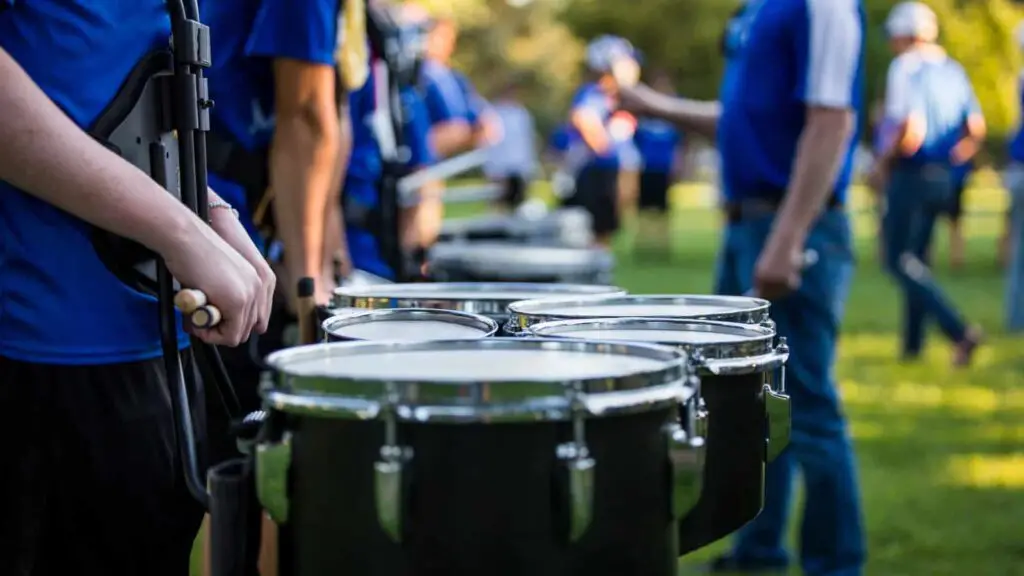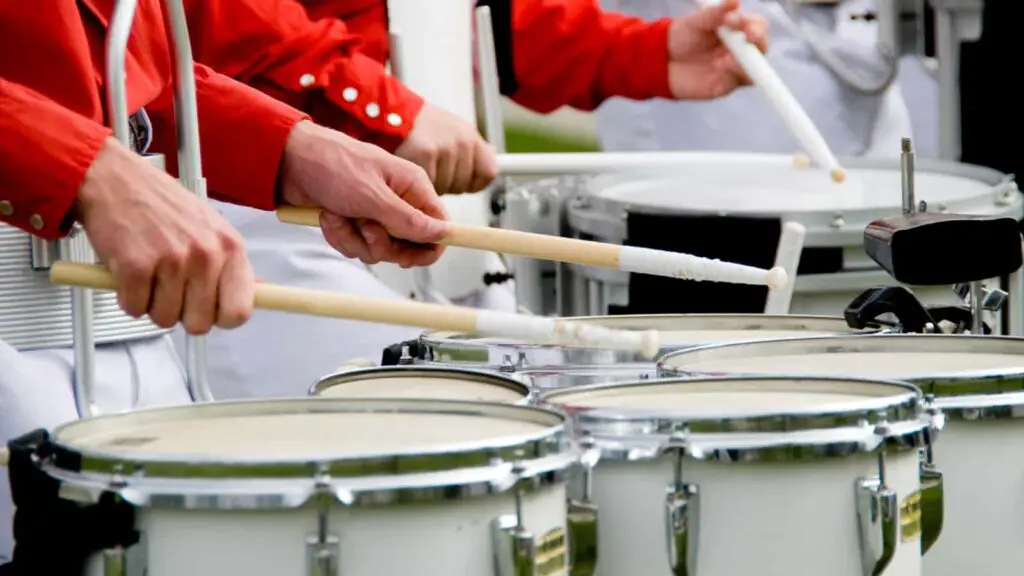Marching bands are known for their vibrant and energetic performances that captivate audiences around the world. These ensembles bring together musicians, color guard performers, and drummers to create a powerful spectacle of sound and motion. Among the various percussion instruments used in marching bands, the tenor drum stands out for its unique role and distinctive sound.
Introduction
Tenor Drum is a type of percussion instrument commonly used in marching bands, specifically designed to be worn and played while marching. It is played with drumsticks and typically produces a deep and resonant sound. The tenor drum adds rhythmic complexity, visual flair, and an additional layer of percussive power to the overall ensemble.
Marching bands, also known as drum corps or drum and bugle corps, are musical groups that combine brass, woodwind, percussion, and color guard performers. They are often seen performing at parades, sporting events, halftime shows, and competitions. These bands showcase precision marching formations, intricate musical arrangements, and synchronized visual effects.

History of Tenor Drums
The history of tenor drums can be traced back to ancient times, where variations of the instrument were used in different cultures for ceremonial and military purposes. Over the centuries, the design and construction of tenor drums have evolved, adapting to changing musical styles and performance requirements.
In the context of marching bands, tenor drums gained prominence during the early 20th century. As marching band arrangements became more intricate, the need for additional percussion instruments arose. The tenor drum emerged as a versatile and visually striking component, capable of enhancing the overall musical experience.
Types of Tenor Drums
There are several types of tenor drums used in different marching band traditions. Each type has its own distinct characteristics and playing techniques.
Traditional Tenor Drums
Traditional tenor drums are often seen in American-style marching bands. They typically consist of a set of three or more drums suspended from a harness worn by the drummer. The drums are of varying sizes, with the largest drum positioned in the center and smaller drums on either side. This configuration allows for a wider range of pitches and tonalities to be produced.

Pipe Band Tenor Drums
In pipe bands, tenor drums play a vital role in providing rhythmic accompaniment to the bagpipes. These drums are usually larger in size and are played with mallets instead of drumsticks. Pipe band tenor drumming involves intricate patterns and techniques that complement the melodies played by the bagpipes.
Corps-style Tenor Drums
Corps-style tenor drums, also known as quint tenors, are commonly found in drum and bugle corps. These drums are typically arranged in a set of five, with the central drum being the largest and the drums on either side gradually decreasing in size. Corps-style tenor drumming involves highly complex and visually captivating performances, often incorporating intricate stick tricks and choreography.
Anatomy of a Tenor Drum
To understand the tenor drum and its capabilities, it’s important to familiarize yourself with its various components.
Shell
The shell of a tenor drum is typically made of wood or synthetic materials such as fiberglass or carbon fiber. The depth of the shell determines the drum’s pitch and resonance. Different materials and construction techniques can also affect the drum’s overall tone.
Hoops and Tension Rods
Tenor drums have metal hoops that secure the drumheads in place. Tension rods are used to tighten the drumheads, allowing players to adjust the drum’s pitch and tone. Proper tensioning of the drumheads is crucial for achieving optimal sound quality and projection.
Drumheads
Tenor drums usually have two drumheads: a batter head and a resonant head. The batter head is the top drumhead that is struck with drumsticks, while the resonant head is located on the bottom and helps amplify the drum’s sound. Different types of drumheads, such as single-ply or double-ply heads, can influence the drum’s sound characteristics.
Carrying Harness
To facilitate playing while marching, tenor drums are equipped with a carrying harness. The harness is worn by the drummer and supports the weight of the drums, allowing for mobility and ease of performance. Proper adjustment and fit of the harness are essential for comfort and proper technique.
Playing Techniques
Playing the tenor drum requires a combination of technique, precision, and showmanship. Here are some key aspects of tenor drumming:
Grip and Sticks
Tenor drummers typically use matched grip, holding the drumsticks with palms facing down. The grip should be relaxed yet firm, allowing for control and agility. The sticks used can vary in size and weight, depending on the player’s preference and the desired sound.
Tip: Taking good care of your sticks is important as a percussionist. Check out our article that has listed Best Marching Mallet & Drumstick Bags (What to Avoid)
Rudiments and Patterns
Tenor drummers utilize a variety of rudiments and patterns to create rhythmic complexity and musicality. These include rolls, flams, drags, paradiddles, and more. Mastery of these rudiments allows for intricate and expressive drumming performances.
Visual Performance
In addition to producing rhythmic accompaniment, tenor drummers are also expected to contribute to the visual appeal of the marching band. They incorporate choreographed movements, stick tricks, and precise synchronization to create visually stunning performances that enhance the overall showmanship.
Role of Tenor Drums in Marching Bands
Tenor drums play a crucial role in the overall sound and visual presentation of marching bands. Here’s how they contribute:
Accompanying the Rhythm Section
The tenor drums, along with the bass drum, snare drum, and cymbals, form the rhythm section of a marching band. They provide the foundational beat and groove that drive the music forward. The tenor drums add depth, complexity, and a distinctive low-end sound to the ensemble, complementing the melodies played by other instruments.
Visual Appeal and Showmanship
Tenor drums are not only an auditory component but also a visual spectacle in marching bands. The synchronized movements and choreography of the tenor drummers contribute to the overall visual presentation of the band. Their precise drumming techniques, stick tricks, and coordinated body movements captivate the audience and enhance the overall performance.
Skills and Challenges of Tenor Drummers
Being a tenor drummer in a marching band requires a unique set of skills and presents specific challenges. Here are some aspects that tenor drummers need to master:
Physical Demands
Tenor drumming requires physical endurance and stamina. The weight of the drums, coupled with the continuous movement and playing, can be physically demanding. Tenor drummers must build strength, agility, and endurance to perform at their best during lengthy rehearsals and performances.
Coordination and Timing
Playing the tenor drums involves intricate coordination between both hands and the use of different drumheads. Tenor drummers must develop a strong sense of timing and precision to execute complex rhythmic patterns accurately. It requires practice to achieve seamless transitions between different drumheads and maintain a consistent groove.
Musicality and Expressiveness
Beyond the technical aspects, tenor drummers must also cultivate musicality and expressiveness in their playing. They need to understand the musical context and contribute creatively to the band’s overall sound. Adding dynamics, accents, and nuanced phrasing elevates the musical experience and makes the performance more engaging.
Famous Tenor Drummers and Performances
Throughout history, several tenor drummers have made a significant impact on the world of marching bands. Their skill, innovation, and memorable performances have left a lasting impression. Some notable tenor drummers and performances include:
Notable Drummers
- John Pratt: Known for his contributions to rudimental drumming and his groundbreaking techniques on tenor drums.
- Jeff Queen: Renowned for his technical prowess and innovative approach to tenor drumming.
- Scott Johnson: A celebrated drummer and instructor who has influenced countless tenor drummers with his musicality and showmanship.
Iconic Performances
- “Blast!” Drum Corps: This Tony Award-winning production featured a captivating ensemble of tenor drummers, showcasing their technical skill and theatrical performance.
- Blue Devils Drum and Bugle Corps: Known for their visually stunning performances, including intricate choreography and dynamic tenor drum sections.
- The Top Secret Drum Corps: A Swiss-based drumline renowned for their precision, synchronization, and visually stunning tenor drum performances.
Tenor Drum Maintenance and Care
Proper maintenance and care are essential to keep tenor drums in optimal condition. Here are some key considerations:
Cleaning and Maintenance
Regularly clean the drum shells, hardware, and drumheads to remove dirt, debris, and excess moisture. Use appropriate cleaning agents and follow manufacturer guidelines to ensure the longevity of the instrument.
Drumhead Replacement
Drumheads wear out over time and need replacement. Regularly inspect the drumheads for signs of wear, such as dents, tears, or a loss of tension. Replace them when necessary to maintain the desired sound quality.
Storage and Transportation
When not in use, store tenor drums in a suitable case or bag to protect them from dust, moisture, and potential damage. During transportation, secure the drums properly to prevent any accidents or mishaps.
Conclusion
Tenor drums play a vital role in the world of marching bands, adding rhythm, depth, and visual spectacle to performances. Mastering the techniques and skills required to play the tenor drum takes dedication, practice, and a keen sense of musicality. Tenor drummers contribute to the overall sound, rhythm, and visual appeal of marching bands, showcasing their talent and showmanship.
Whether it’s the traditional tenor drums in American-style marching bands, the rhythmic accompaniment of pipe band tenor drums, or the intricate performances of corps-style tenor drums in drum and bugle corps, these instruments bring a unique dynamic to the marching band experience.
Throughout history, tenor drummers have made their mark with their innovative techniques and performances. Notable drummers like John Pratt, Jeff Queen, and Scott Johnson have inspired aspiring tenor drummers with their technical prowess and musicality.
Iconic performances by ensembles such as the “Blast!” Drum Corps, the Blue Devils Drum and Bugle Corps, and the Top Secret Drum Corps have captivated audiences with their visually stunning and musically impressive tenor drum sections.
To maintain and care for tenor drums, regular cleaning, maintenance, and drumhead replacements are essential. Proper storage and transportation methods should also be followed to protect these valuable instruments.
In conclusion, tenor drums are a vital component of marching bands, bringing rhythm, depth, and visual flair to performances. The skills and techniques of tenor drummers contribute to the overall musicality and showmanship of the ensemble. Celebrate the impact and contribution of tenor drums in marching bands, where music and motion unite to create a truly unforgettable experience.
FAQs
- What is the purpose of a tenor drum in a marching band?
- Tenor drums add rhythmic complexity, depth, and visual appeal to the marching band’s performance. They contribute to the overall sound and enhance the showmanship of the ensemble.
- How many drums are typically used in a tenor drum set?
- The number of drums in a tenor drum set varies depending on the marching band’s style and tradition. It can range from three drums in a traditional set to five or more drums in corps-style sets.
- Can tenor drumming be learned without prior drumming experience?
- While prior drumming experience can be beneficial, it is not a strict requirement. With dedication, practice, and proper instruction, individuals can learn tenor drumming techniques and become proficient players.
- Are there any specific techniques for playing tenor drums?
- Yes, tenor drumming involves specific techniques such as grip and stick control, rudiments, and visual performance. Learning these techniques and practicing them consistently is crucial for mastering the instrument.
- What are some popular marching bands known for their tenor drum sections?
- Some popular marching bands known for their impressive tenor drum sections include the Blue Devils Drum and Bugle Corps, Santa Clara Vanguard, and Carolina Crown.
Disclaimer: This post may contain affiliate links. We only recommend high-quality products that are used and recommended by real musicians. If you use these links to buy something we earn a small commission.
